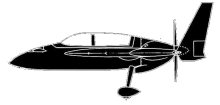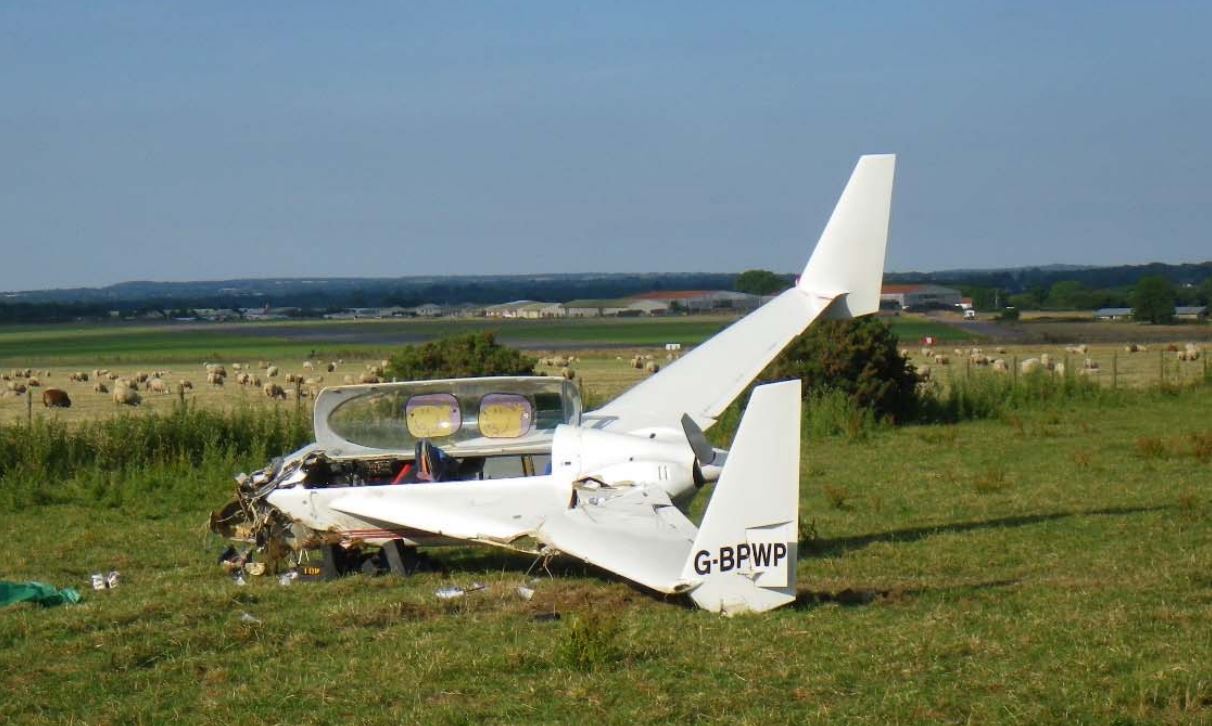
ASN Wikibase Occurrence # 213001
This information is added by users of ASN. Neither ASN nor the Flight Safety Foundation are responsible for the completeness or correctness of this information.
If you feel this information is incomplete or incorrect, you can submit corrected information.
| Date: | Saturday 7 July 2018 |
| Time: | 12:31 LT |
| Type: |  Rutan Long-EZ |
| Owner/operator: | Private |
| Registration: | G-BPWP |
| MSN: | PFA 074A-11132 |
| Year of manufacture: | 1989 |
| Engine model: | Continental O-240-E |
| Fatalities: | Fatalities: 0 / Occupants: 2 |
| Aircraft damage: | Substantial |
| Location: | near Dunkeswell Airfield (EGTU), Honiton, Devon -
 United Kingdom United Kingdom
|
| Phase: | Landing |
| Nature: | Private |
| Departure airport: | London-Biggin Hill Airport (BQH/EGKB) |
| Dunkeswell Airfield (EGTU), Devon | |
| Investigating agency: | AAIB |
| Confidence Rating: |
The pilot and his passenger planned to fly from Biggin Hill Airport, where the aircraft was kept in a hangar, to Dunkeswell Airfield. The aircraft departed at 1013 hrs, with the right fuel tank selected and about 20 gal of fuel on board. The flight progressed through southern England without event, during which time the pilot selected the left fuel tank when the right tank indicated about 6 gal. The fuel selector remained in this position for the rest of the flight.
As the aircraft approached Dunkeswell, the pilot requested joining instructions. At about this time the passenger advised the pilot that the fuel tanks indicated 4 and 6 gal (left and right tanks respectively) and asked the pilot if he should change tanks. As the engine was “running fine” the pilot replied “no”. The Radio Controller informed the pilot that he should join right-hand downwind for Runway 04. Having joined downwind at about 1,000 ft aal, the pilot selected carburettor heat to hot; he could not recall if he turned the fuel booster pump on at this time. He then turned the carburettor heat to cold at the end of the downwind leg.
The pilot became aware of two aircraft lining up on Runway 04 and decided to extend the downwind leg. Once the two aircraft had cleared the runway, he turned on to base leg and attempted to re-establish his normal circuit profile at a speed of 65 to 70 kt. The pilot believes that he turned the carburettor heat to hot while on base leg.
Just before the pilot turned onto final approach, the engine stopped without warning. The pilot transmitted a PAN followed shortly thereafter by a MAYDAY. He attempted to restart the engine once, to no avail, and prepared to land in a field in the undershoot. He does not recall changing fuel tanks or checking that the fuel booster pump was on. At about 20 ft agl he became aware of a fence ahead of the aircraft and turned left to avoid it. The aircraft subsequently landed firmly with left bank applied.
Once the aircraft had come to rest the pilot asked his passenger if she was “OK”, opened the canopy and told her not to move but to await assistance. The airfield’s emergency response vehicles were quickly on the scene and, with some of the eye witnesses, administered first aid to the occupants. The local RFFS, ambulance and air ambulance arrived soon thereafter and removed both occupants from the aircraft and transported them to hospital; the passenger, who had minor injuries, went by road and the pilot, who suffered serious injuries, went by air.
Conclusion
The aircraft’s engine most likely stopped because of either carburettor icing or fuel vapour lock. The probability of these factors occurring would have increased as a result of using Mogas, which the aircraft was not authorised for, and not ensuring that the electrical fuel pump and carburettor heat were selected on during the approach and landing. Following the engine failure the pilot would have been faced with a steeper than normal glide approach and most likely did not arrest the high rate of descent sufficiently before the aircraft touched down firmly.
Accident investigation:
 |
|
Sources:
1. https://www.devonlive.com/news/devon-news/plane-crash-dunkeswell-honiton-aircraft-1759853
2. https://www.somersetlive.co.uk/news/man-injured-devon-plane-crash-1760147
3. https://siteapps.caa.co.uk/g-info/
4. http://wings-on-film.wikia.com/wiki/G-BPWP
5. https://abpic.co.uk/pictures/registration/G-BPWP
6. https://forums.flyer.co.uk/viewtopic.php?f=1&t=108891&sid=109ced7e270773663881cc63a1fa2f7a
7. https://www.gov.uk/government/publications/aaib-current-field-investigations/air-accidents-investigation-branch-current-field-investigations
Images:

Photo: AAIB
Media:
We took aerial photos of the plane crash today at #Dunkeswell on behalf of @DC_Police & the @aaibgovuk. Log 503 pic.twitter.com/VnuvH3knjg
— Ade Taylor (@NPASTFO_AT) July 7, 2018
#Fire crews attended a light #aircraft crash #Dunkeswell Airfield #Honiton involving two casualties
— Devon&Somerset Fire (@DSFireUpdates) July 7, 2018
Revision history:
| Date/time | Contributor | Updates |
|---|---|---|
| 07-Jul-2018 19:23 | Captain Adam | Added |
| 07-Jul-2018 19:28 | harro | Updated [Aircraft type, Operator] |
| 07-Jul-2018 20:36 | Geno | Updated [Aircraft type, Registration, Cn, Total occupants, Location, Source, Narrative] |
| 08-Jul-2018 05:58 | Aerossurance | Updated [Location, Nature, Narrative] |
| 09-Jul-2018 16:35 | Dr. John Smith | Updated [Destination airport, Source, Embed code, Narrative] |
| 18-Oct-2018 17:06 | Dr.John Smith | Updated [Source, Embed code, Narrative] |
| 14-Feb-2019 19:34 | harro | Updated [Time, Departure airport, Narrative, Photo, Accident report, ] |
| 17-Mar-2019 22:48 | Dr. John Smith | Updated [Location, Departure airport, Narrative] |
Corrections or additions? ... Edit this accident description
The Aviation Safety Network is an exclusive service provided by:


 ©2024 Flight Safety Foundation
©2024 Flight Safety Foundation